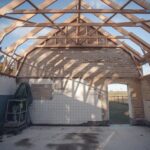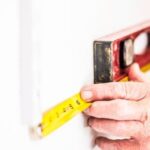The ability to take advantage of tax benefits is a consideration for many homeowners when planning home improvements. Understanding what counts as a home improvement for tax basis is crucial in maximizing these benefits. In this article, we will delve into the key differences between home improvements and repairs, explore the IRS guidelines for tax-deductible home improvement expenses, and discuss how home improvements affect the value of your property.
The distinction between home improvements and repairs is important when it comes to determining their impact on tax basis. Home improvements are generally defined as enhancements that increase the value, prolong the useful life, or adapt a property to new uses. Repairs, on the other hand, are considered maintenance tasks that restore a property to its original condition. Identifying which category an expense falls into can have significant implications for your tax deductions.
To fully understand what counts as a tax-deductible home improvement expense, it is essential to be familiar with the IRS guidelines. The IRS provides specific criteria and rules regarding qualifying improvements for tax deductions. It is crucial to know which expenditures meet these guidelines in order to claim relevant deductions correctly.
Furthermore, undertaking home improvements can also impact the overall value of your property and subsequently affect your tax basis. Calculating your tax basis is essential in determining capital gains or losses when you sell your property. By understanding how specific home improvements contribute to increasing your property’s value, you can make informed decisions that not only enhance your living space but also provide financial benefits in the long run.
In the following sections of this article, we will explore strategies for maximizing tax savings through claiming appropriate deductions for home improvements while highlighting common pitfalls to avoid. Real-life examples will illustrate how different scenarios can impact your tax basis and provide practical insights into managing these situations effectively. Finally, we will address frequently asked questions about home improvements and their relationship with tax basis to ensure a comprehensive understanding of this topic.
Defining Home Improvements vs. Repairs
When it comes to tax deductions for home improvements, it is essential to understand the distinction between home improvements and repairs. While these terms are often used interchangeably, they have different implications when it comes to calculating your tax basis.
Home improvements refer to any renovations or additions that enhance the value of your property, prolong its useful life, or adapt it for a new use. They typically involve major enhancements such as adding a room, remodeling a kitchen or bathroom, installing a swimming pool, or upgrading the heating and cooling system. On the other hand, repairs are considered routine maintenance tasks that keep your property in good working condition without significantly increasing its value or lifespan.
The distinction between home improvements and repairs is crucial because they impact how you calculate your tax basis. Tax basis refers to the amount of money that you have invested in your property for tax purposes. It is used to determine the gain or loss when you sell your property.
Home improvements increase your tax basis by adding to the original cost of acquiring or constructing the property. This means that when you sell your property, you can subtract the increased tax basis from the sale price to determine whether you have made a gain or a loss.
To better understand how home improvements and repairs impact tax basis, let’s consider an example. Suppose you purchased a house for $300,000 and spent $50,000 on a kitchen renovation. In this case, your tax basis increases to $350,000 ($300,000 + $50,000). If you sell the house for $400,000 in the future, you would only be taxed on the gain of $50,000 ($400,000 – $350,000), rather than on the entire sale price.
It is important to carefully document all home improvement expenses and keep receipts as evidence for potential IRS audits. Additionally, if you plan on claiming deductions for home improvements on your taxes, it is recommended to consult with a tax professional to ensure compliance with tax laws and regulations.
Identifying Tax-Deductible Home Improvement Expenses
Homeowners who are looking to maximize their tax benefits should be aware of the various home improvement expenses that may qualify for tax deductions. This section will provide a comprehensive list of tax-deductible home improvement expenses, helping homeowners understand which costs they can potentially write off when filing their taxes.
When it comes to tax-deductible home improvement expenses, it’s important to note that not all renovation costs are eligible for deductions. Generally, only improvements that add value to the taxpayer’s property or prolong its useful life can be considered tax-deductible. Repairs, on the other hand, do not typically qualify for deductions as they are simply fixing existing issues without adding any value.
Here is a comprehensive list of tax-deductible home improvement expenses:
- Adding square footage to the property (e.g., room additions or expansions)
- Installing a new roof Upgrading heating, ventilation, and air conditioning (HVAC) systems Remodeling or renovating the kitchen or bathrooms Installing energy-efficient windows, insulation, or doors Adding a new deck or patio Constructing a garage or carport Upgrading electrical wiring and plumbing systems Adding landscaping or outdoor amenities (e.g., swimming pool)
- Installing security systems It is important for homeowners to keep thorough records of their home improvement expenses, including invoices, receipts, contracts, and any other relevant documentation that demonstrates the cost and nature of the improvements made. This documentation will be crucial when claiming deductions on these expenses during tax season.
In order to determine whether specific home improvements qualify for tax deductions, it is essential to consult the guidelines outlined by the Internal Revenue Service (IRS). These guidelines outline what types of improvements are considered eligible for deductions and help homeowners ensure they meet all necessary requirements before claiming these deductions on their taxes.
Overall, identifying tax-deductible home improvement expenses is crucial for homeowners looking to maximize their tax benefits. By understanding which improvements qualify for deductions and maintaining accurate records, homeowners can take full advantage of the financial benefits that come with investing in their properties.
| Examples of Tax-Deductible Home Improvement Expenses | Description |
|---|---|
| Adding square footage to the property | This includes room additions or expansions that increase the overall size of the home. |
| Installing a new roof | The cost of replacing an old or damaged roof is considered a tax-deductible home improvement expense. |
| Remodeling or renovating the kitchen or bathrooms | Any upgrades or renovations done to improve the kitchen or bathroom’s functionality and value can be claimed as tax deductions. |
Exploring the IRS Guidelines
Understanding the IRS Guidelines
When it comes to home improvements, it’s essential to be aware of the guidelines set by the IRS regarding which expenses can qualify for tax deductions. While not all home improvements can be used to claim tax deductions, there are specific criteria that determine which expenses are eligible. Understanding these guidelines can help you maximize your tax benefits and ensure that you meet all necessary requirements.
Qualifying Home Improvement Expenses
According to the IRS guidelines, a home improvement expense must meet certain criteria in order to be eligible for tax deductions. Firstly, the improvement must be considered a substantial addition or enhancement that increases the value of your property. Examples of qualifying improvements include adding a new room, remodeling a kitchen or bathroom, installing new flooring or windows, or building an addition such as a deck or garage.
It’s important to note that routine repairs and maintenance do not qualify as deductible home improvement expenses. Repairs are generally considered as fixes done to restore or keep your property in good condition without adding significant value or appreciably prolonging its life. Some examples of repairs include fixing a leaky faucet, replacing broken tiles, patching up a roof, or repainting walls.
The Importance of Proper Documentation
To ensure that you can successfully claim tax deductions for your home improvement expenses, it is crucial to maintain detailed records and documentation. Keep receipts, contracts, invoices, and any other supporting documents related to the improvement project. This documentation should clearly outline the nature of the improvement work done and provide evidence of any costs incurred.
Additionally, it’s advisable to take “before” and “after” photographs of the areas that have undergone improvements. These visual records can help substantiate your claims if ever questioned by the IRS. By maintaining thorough documentation throughout your home improvement process, you can significantly reduce the risk of potential disputes or denials when claiming tax deductions.
Overall, it is important to consult with a qualified tax professional or refer directly to the IRS guidelines for specific information on what home improvements qualify for tax deductions. By ensuring that your expenses meet the necessary criteria and maintaining proper documentation, you can maximize your tax benefits while enhancing the value of your property.
Key Considerations for Calculating Tax Basis
When it comes to calculating tax basis, understanding how home improvements can affect the value of your property is crucial. Home improvements can have a significant impact on your property’s value, which in turn can affect your tax obligations. Here are some key considerations to keep in mind when calculating tax basis and evaluating the impact of home improvements on your property:
Firstly, it’s important to understand that not all home improvements increase the tax basis of your property. According to the IRS guidelines, home improvements need to provide a permanent benefit and add value to your property in order to be considered for tax deductions. This means that repairs and maintenance work, such as fixing a leaky roof or replacing a broken window, do not count as home improvements for tax purposes.
On the other hand, certain types of home improvements can significantly increase the value of your property and positively impact your tax basis. For example, additions such as adding an extra bedroom or bathroom, expanding the living space, or constructing a garage or a swimming pool are considered substantial improvements that can enhance the value of your property.
It’s also worth noting that not all expenses related to home improvements are eligible for tax deductions. While materials and labor costs for qualifying home improvement projects may be deductible, expenses for furniture, appliances, or cosmetic enhancements typically do not count towards increasing your tax basis.
Calculating the exact impact of home improvements on your property’s value can be complex. It often requires professional assistance from appraisers or real estate experts who can evaluate the market value of your property before and after the improvement project. Keeping detailed records of all relevant expenses and documentation related to the improvement work is essential for accurately determining its impact on your tax basis.
By understanding these key considerations about how home improvements affect the value of your property and consequently impact your tax basis, you can make informed decisions about which improvement projects qualify for tax deductions and ultimately maximize your potential savings.
Maximizing Tax Savings
Keep Detailed Records
When it comes to claiming home improvement deductions on your taxes, one of the most important things you can do is keep detailed records. This includes all receipts, invoices, and contracts related to the improvements you have made.
Keeping these records organized and easily accessible will make it much easier when it comes time to file your tax return. Additionally, having accurate documentation will provide evidence of the expenses you incurred and can help support your claims in case of an audit.
Understand Eligible Expenses
To maximize your tax savings, it’s crucial to understand what expenses qualify as eligible deductions. Generally, improvements that increase the value of your property, prolong its useful life, or adapt it for new uses can be considered eligible for deductions. For example, adding a new room, renovating a bathroom or kitchen, installing energy-efficient windows or doors – these are all examples of home improvements that may qualify for tax deductions.
However, it’s essential to note that regular repairs and maintenance do not count as eligible expenses. Repairs are simply fixing existing problems or restoring something back to its original condition. To ensure you are accurately categorizing your expenses and claiming the appropriate deductions, consult with a tax professional or refer to IRS guidelines.
Take Advantage of Tax Credits
In addition to deductions, there are also tax credits available for certain types of home improvements. Unlike deductions that reduce your taxable income, tax credits directly reduce the amount of tax you owe. For example, installing solar panels or other renewable energy systems may qualify you for a Residential Energy Efficient Property Credit.
It’s important to research and understand the specific criteria and requirements for each type of credit before attempting to claim them on your taxes. The IRS website provides detailed information on available credits and how to claim them. Furthermore, consulting with a tax professional can help ensure you are taking full advantage of any available tax credits and maximizing your overall tax savings.
Common Mistakes to Avoid
Owning a home comes with the opportunity to make improvements that not only enhance your living environment but also provide potential tax benefits. However, it’s important to be aware of common mistakes that could jeopardize your home improvement tax basis. By avoiding these pitfalls, you can ensure that you maximize your tax savings and protect the value of your property.
One common mistake to avoid is failing to keep accurate records of your home improvement expenses. When claiming deductions for home improvements on your taxes, it’s crucial to have proper documentation. This includes keeping receipts, invoices, and other relevant documents that show the cost of materials, labor, and any other expenses related to the improvement project. Without these records, it may be difficult to prove the legitimacy of your deductions if you ever face an audit.
Another mistake that homeowners often make is incorrectly classifying repairs as home improvements. While repairs are necessary for maintaining the condition of your property, they do not typically qualify as home improvements for tax purposes. Repairs are considered regular maintenance expenses, whereas home improvements involve adding value or increasing the lifespan of your property. It’s essential to understand and accurately differentiate between repairs and improvements when determining what qualifies for tax deductions.
Additionally, timing is an important consideration when claiming home improvement deductions on your taxes. Some homeowners make the mistake of deducting expenses for projects that haven’t been completed within the taxable year. According to IRS guidelines, in order to claim a deduction for a home improvement project, it must be “placed in service” during the taxable year.
This means that the project should be substantially complete and ready for use before December 31st. Failing to meet this requirement may result in disqualification for the deduction.
To avoid these mistakes and maintain a solid tax basis for your home improvements, it is advisable to consult with a tax professional or seek guidance from the IRS. They can provide clarity on the specific rules and guidelines related to home improvement deductions and help you navigate any uncertainties. By staying informed and proactive, you can ensure that your home improvements not only enhance your living space but also provide valuable tax benefits for your financial future.
Real-Life Examples
When it comes to home improvements and their impact on tax basis, understanding real-life examples can help clarify the concepts and give you a clearer picture of how these improvements can affect your taxes. Here are some scenarios that demonstrate how different types of home improvements can have varying effects on tax basis:
- Scenario 1: Energy-Efficient Upgrades In this scenario, homeowners decided to invest in energy-efficient upgrades for their home, such as installing solar panels and upgrading their insulation. These improvements not only reduce energy consumption but also qualify for various tax incentives and credits.
By claiming these deductions correctly, the homeowners were able to increase their tax basis. As a result, they were entitled to larger tax savings and potentially higher resale value if they decide to sell their property in the future. - Scenario 2: Cosmetic Enhancements In this scenario, homeowners focused on cosmetic enhancements such as remodeling their kitchen and bathrooms, replacing flooring, and adding a fresh coat of paint throughout their home. While these improvements certainly enhanced the aesthetic appeal of the property, they do not directly qualify for tax deductions.
However, they could indirectly impact the tax basis by increasing the overall value of the property. Therefore, if these homeowners decide to sell their property down the line, they may be subject to capital gains taxes on the increased value resulting from these cosmetic improvements. - Scenario 3: Accessibility Modifications Consider a scenario where homeowners made accessibility modifications to accommodate an elderly family member or someone with disabilities. These modifications may include installing ramps or lifts, widening doorways, or adding grab bars in bathrooms.
In this case, these improvements can be considered medical expenses and may be deductible under certain circumstances. However, it is important to consult IRS guidelines or a tax professional to determine eligibility for deductions and credits related to accessibility modifications.
Frequently Asked Questions
For many homeowners, understanding the relationship between home improvements and tax basis can be a complex matter. To provide clarity on this topic, we have compiled a list of frequently asked questions to address common queries about home improvements and tax basis.
- What is considered a home improvement for tax purposes?
- Are all home improvements tax-deductible?
- How do home improvements affect the tax basis of my property?
- Should I keep track of my home improvement expenses?
Home improvements, in the context of tax basis, refer to any enhancements made to a property that increase its value or prolong its useful life. This can include renovations such as adding an additional room, installing a new roof, or upgrading the kitchen appliances. Repairs, on the other hand, are expenses incurred to keep the property in good condition but do not add substantial value or extend its lifespan.
Not all home improvements are eligible for tax deductions. The Internal Revenue Service (IRS) has specific guidelines that determine which expenses can be deducted from your taxable income. Generally, improvements that are considered necessary for medical reasons or to accommodate disabilities may be deductible. Energy-efficient upgrades such as solar panels or geothermal heat pumps may also qualify for certain tax credits.
Home improvements can impact the tax basis of your property by increasing it. The tax basis refers to the original cost of acquiring the property plus any additional capital expenses incurred during ownership. When you invest in qualifying home improvements, those costs get added to your tax basis, effectively reducing any potential taxable gains when you sell your property in the future.
Yes. It is crucial to maintain detailed records of all your home improvement expenses, including invoices, receipts, and contracts. These documents will serve as evidence if you ever need to substantiate your deductions during an IRS audit or when calculating your tax basis when selling your property.
By addressing these common questions, homeowners can gain a clear understanding of how home improvements impact tax basis. Being knowledgeable about this subject can help maximize potential tax deductions and financial benefits while avoiding costly mistakes or misunderstandings with the IRS.
Conclusion
In conclusion, understanding the importance of home improvements for tax basis is crucial for maximizing tax benefits and securing a strong financial future. By differentiating between home improvements and repairs, homeowners can determine which expenses are tax-deductible and enhance the value of their property.
Identifying tax-deductible home improvement expenses is essential to ensure that individuals can take advantage of potential deductions. From major renovations to energy-efficient upgrades, there are a wide range of improvements that qualify for tax deductions. By familiarizing oneself with the IRS guidelines, homeowners can confidently claim these deductions and maximize their tax savings.
Calculating tax basis is another key consideration when it comes to home improvements. Enhancing the value of your property through renovations can increase your tax basis, which in turn may reduce your taxable gain when you sell. It is important to keep thorough records and documentation of all home improvements made as they will be essential in determining your adjusted cost basis.
To further maximize tax savings, homeowners should consider various tips and strategies for claiming home improvement deductions. This includes taking advantage of available credits, utilizing energy-efficient upgrades, and consulting with a tax professional to ensure compliance with all regulations.
However, it’s important to be aware of common mistakes that could jeopardize your home improvement tax basis. Properly documenting expenses, ensuring they meet IRS guidelines, and avoiding fraudulent claims are all essential in protecting your eligibility for deductions.
Real-life examples demonstrate how home improvements can have a significant impact on tax basis in various scenarios. By analyzing these cases, homeowners can understand how their own situations may warrant specific strategies or considerations.
In summary, utilizing home improvements effectively can not only enhance the value and enjoyment of your property but also provide valuable tax benefits.
By understanding the differences between repairs and improvements, identifying deductible expenses, following IRS guidelines, calculating your tax basis accurately, maximizing opportunities for savings through tips and strategies, avoiding common mistakes, considering real-life examples, and seeking professional advice when necessary, homeowners can ensure they are making the most of their home improvements to enhance tax benefits and secure their financial future.
Frequently Asked Questions
What improvements increase the basis of a home?
Improvements that increase the basis of a home are those that enhance its value or extend its useful life. This can include major renovations such as adding an additional room, remodeling the kitchen or bathroom, installing a swimming pool, or adding a garage.
Additionally, improvements that increase energy efficiency like adding solar panels or installing new windows and insulation can also contribute to an increased basis.
What home improvements are tax-deductible IRS?
The IRS allows tax deductions for certain home improvements that qualify under specific circumstances. These deductions typically fall under the category of medical expenses if the improvement is deemed medically necessary.
For example, if a homeowner installs ramps or lifts for accessibility purposes due to a disability or illness, these costs may be deductible as medical expenses. It’s important to consult with a tax professional or refer to IRS publications for specific guidelines and qualifications for deducting home improvements.
What are examples of improvements that increase basis?
Examples of improvements that increase the basis of a home are numerous and varied. They typically involve substantial changes or additions to the property’s structure or function that go beyond simple repairs and maintenance.
Some examples include renovating outdated plumbing or electrical systems, replacing the roof, adding an extension to the house, upgrading HVAC systems, building custom cabinetry, refinishing hardwood floors, or constructing outdoor living spaces like patios or decks. These types of improvements not only enhance the property’s value but also improve its overall quality and functionality for homeowners.

I’m thrilled to have you here as a part of the Remodeling Top community. This is where my journey as an architect and remodeling enthusiast intersects with your passion for transforming houses into dream homes.





